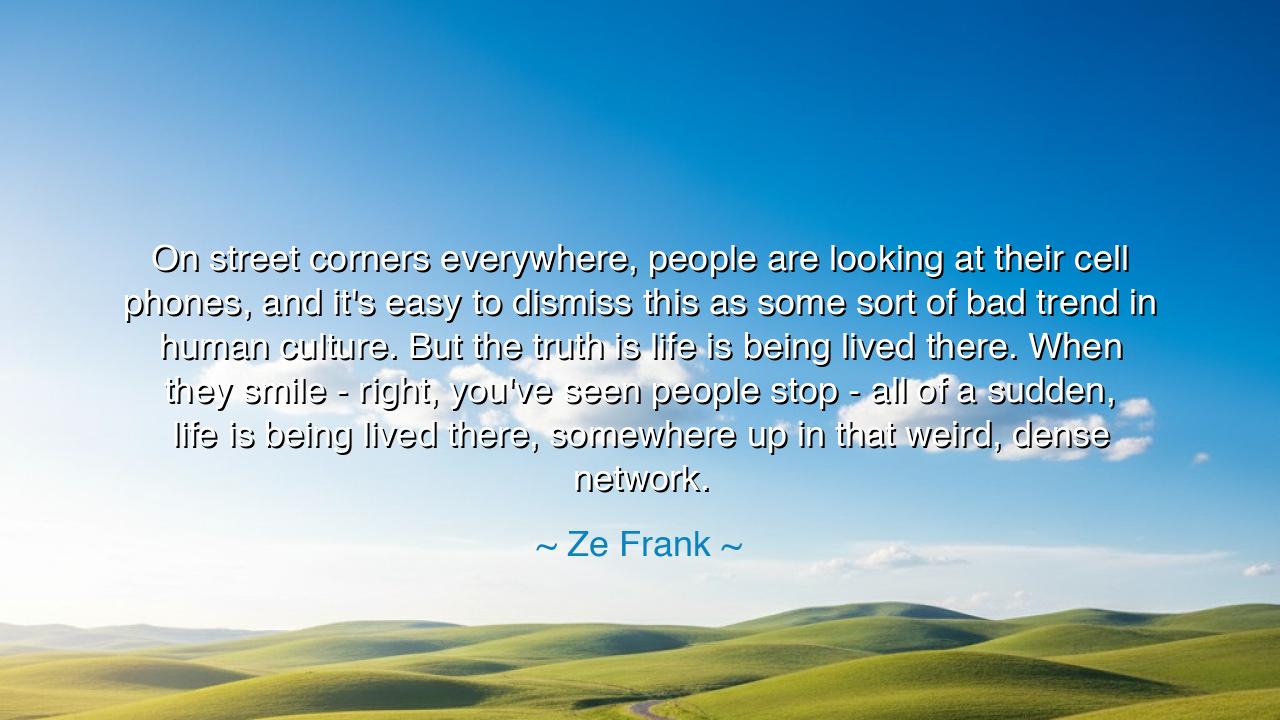
On street corners everywhere, people are looking at their cell
On street corners everywhere, people are looking at their cell phones, and it's easy to dismiss this as some sort of bad trend in human culture. But the truth is life is being lived there. When they smile - right, you've seen people stop - all of a sudden, life is being lived there, somewhere up in that weird, dense network.






Ze Frank once observed with a poet’s eye: “On street corners everywhere, people are looking at their cell phones, and it's easy to dismiss this as some sort of bad trend in human culture. But the truth is life is being lived there. When they smile - right, you've seen people stop - all of a sudden, life is being lived there, somewhere up in that weird, dense network.” These words confront the tension between appearance and reality, between how the modern world looks from the outside and what is truly happening within. For what seems like disconnection is, in fact, another form of connection, woven into the invisible threads of the digital realm.
The ancients would have marveled at such a vision. They knew of networks, but theirs were carved in stone and carried by messengers across deserts and seas. They spoke of the invisible bonds of community, of friendship and kinship, which carried the weight of civilization. Ze Frank tells us that today, those same bonds exist in a new form—no longer only in the marketplace or the temple, but also in the network, a place unseen yet alive with stories, greetings, and exchanges of love. The smile becomes the sign that life is real, no matter where it unfolds.
This truth is confirmed by history. Consider the invention of the printing press: many elders of that age feared it would isolate people, locking them away with books instead of in conversation. Yet it gave birth to revolutions, to enlightenment, to movements that reshaped nations. In the same way, the sight of bowed heads and glowing screens may seem like alienation, but within those devices are friendships renewed, lovers’ words exchanged, families reunited across oceans. When a person smiles at a screen on a street corner, they are not trapped—they are participating in life’s great dance, simply in a new arena.
There is a subtle challenge in Ze Frank’s words as well: to see beyond the surface. The easy judgment is to call it a “bad trend,” to say people are enslaved by machines. But the deeper wisdom is to ask: what is happening within? For when someone suddenly smiles, their spirit is touched—whether by humor, affection, or the warmth of human recognition. And that moment of joy is as authentic as any shared face-to-face. To dismiss it is to mistake the vessel for the essence, the medium for the meaning.
At the heart of his reflection lies a defense of humanity’s adaptability. We have always created tools that carry our stories farther—fire, letters, telegraphs, radios. Each time, people feared these tools would erode true connection. Yet in every age, the tools merely extended the reach of our hearts. The network Ze Frank describes may seem dense and strange, but within it, people still laugh, still grieve, still fall in love. The proof of its reality is in the smile—a sign unchanged by technology, a bridge that remains timeless.
The lesson for us is clear: do not judge life only by appearances. A bowed head on a street corner is not necessarily emptiness—it may be fullness, a moment of communion across distance. Do not scorn the tools of the age, for they are only mirrors of the human soul. Instead, look for the smile, for it is the eternal evidence of life, whether in the marketplace of Athens or the digital networks of today.
So, my children, heed this wisdom: learn to see life where it truly is, not only where tradition says it should be. Do not dismiss the modern world’s forms of connection, but look deeper to the humanity that pulses within them. And when you see a stranger stop and smile at their phone, remember—life is being lived there, just as real, just as sacred, as the laughter of friends around a fire long ago. The forms change, but the essence of joy remains the same.






AAdministratorAdministrator
Welcome, honored guests. Please leave a comment, we will respond soon